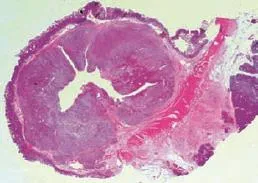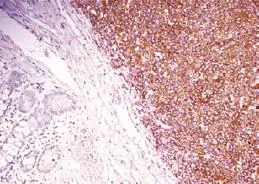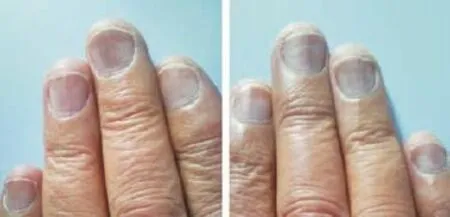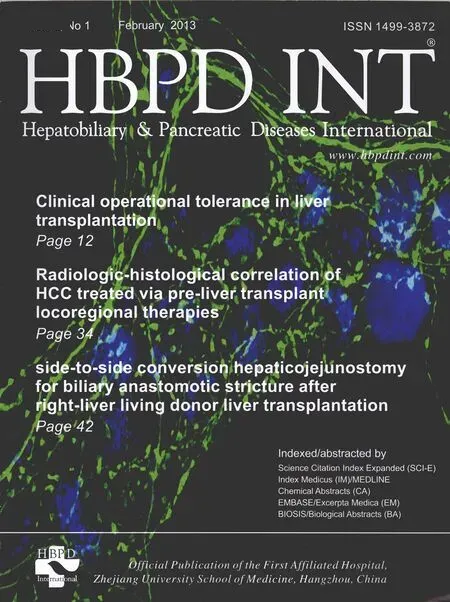Melanoma in the ampulla of Vater
Split, Croatia
Melanoma in the ampulla of Vater
Antonia Bendic, Merica Glavina Durdov, Radoslav Stipic and Ivana Karaman
Split, Croatia
BACKGROUND:The most common tumors in the ampulla of Vater are adenocarcinomas. Although malignant melanoma usually occurs on the skin, it can also arise in the gastrointestinal and biliary tract.
METHOD:We present a case of a 52-year-old, previously healthy man who presented with painless jaundice.
RESULTS:Clinical examination revealed dilated intrahepatic and extrahepatic bile ducts and pancreatic duct due to the obstructive mass in the ampulla of Vater. The patient underwent pancreaticoduodenectomy and histopathological diagnosis of the resected tumor mass was malignant melanoma. Thorough clinical examination was preformed, but no other primary or metastatic site of melanoma could be found. In the next few months, the patient developed multiple liver metastases and died.
CONCLUSION:An isolated amelanotic lesion in the ampulla of Vater can be a potential diagnostic pitfall, especially in patients who have had melanoma.
(Hepatobiliary Pancreat Dis Int 2013;12:106-108)
malignant melanoma; ampulla of Vater; biliary tract
Introduction
Malignant melanoma is a highly aggressive neoplasm which usually occurs on the skin. It has the ability of unpredictable dissemination, mainly to the gastrointestinal (GI) and biliary tract. Visceral metastases are usually multiple, polypoid or ulcerated lesions, pigmented or amelanotic, rarely solitary tumors. Primary malignant melanomas can also occur on the GI and biliary tract mucosa. They are more aggressive, and have a much worse prognosis compared with cutaneous melanoma.[1]We present a case of a 52-year-old man with an isolated obstructive mass occupying the ampulla of Vater, which was histologically identif i ed as malignant melanoma. We discuss the criteria for diagnosis of primary malignant melanoma in the ampulla of Vater in the context of the published cases with review of the literature.
Case report
A 52-year-old, previously healthy man presented with a two-day history of weakness and painless jaundice. Laboratory evaluation showed elevated levels of bilirubin: total bilirubin 300 μmol/L, direct fraction 219 μmol/L, and indirect fraction 81 μmol/L and liver enzymes: alkaline phosphatase 1106 U/L, γ-glutamyltransferase 1576 U/L, aspartate aminotransferase 281 U/L, alanine aminotransferase 489 U/L, and lactate dehydrogenase 239 U/L.
Abdominal ultrasound and multislide computerized tomography revealed a 1.9×1.5 cm hypodense, obstructive mass in the ampulla of Vater. Three regional lymph nodes were enlarged, up to a maximum diameter of 1.5 cm. Intrahepatic and extrahepatic bile ducts as well as the common bile duct and pancreatic duct were dilated up to 1.9 cm in diameter, without intraluminal masses. Other abdominal organs showed no abnormalities. Endoscopic examination revealed a round, well limited, whitish mass occupying the ampulla of Vater. Percutaneous transhepatic cholangiopancreatography was done, and after drainage bilirubin levels were decreased signif i cantly and symptoms were relieved. Pancreaticoduodenectomy by the Whipple procedure was done. A round, fi rm, white nodule, 1.4 cm in diameter, completely surrounded and narrowed the lumen of the ampulla of Vater. It was restricted by duodenal mucosa and pancreatic tissue (Fig. 1). Tumor tissue was composed of massive malignant cells with hyperchromatic nuclei and scant pale cytoplasm but without pigment (Fig. 2). Pancreatic tissue did not show signs of malignant inf i ltration. In one of the three regional enlarged lymph nodes, scatteredmalignant cells identical to those in the ampulla of Vater were found. The duodenal mucosa and stomach had nothing abnormal. Immunohistochemically, tumor cells were vimentin, S-100, melanoma antigen (Fig. 3) positive, but pancytokeratin (Fig. 4), cytokeratin 7, cytokeratin 8, cytokeratin 20, leukocyte common antigen, chromogranin, sinaptophizin and neurof i lament negative. The proliferation activity measured by the expression of Ki-67 was high (>90%). Same immunohistochemical pattern was found in the inf i ltrated lymph node. Pathological examination of the resected tumor mass revealed a malignant melanoma. Complete clinical overview was done, but other primary or metastatic sites could not be found. Two months after the diagnosis the patient developed multiple liver metastases and died 4 months later.

Fig. 1.Tumor surrounding and narrowing the lumen of the ampulla of Vater (HE, original magnif i cation ×20).

Fig. 2.Tumor cells with large nuclei, scant cytoplasm without pigment (HE, original magnif i cation ×400).

Fig. 3.Tumor cells are intensively positive for melanoma antigen (immunohistochemical staining for melanoma antigen, original magnif i cation ×200).

Fig. 4.Pancytokeratin positive ampullary epithelium in contrast to pancytokeratin negative tumor cells (immunohistochemical staining for pancytokeratin, original magnif i cation ×100).
Discussion
Primary GI and biliary melanoma is rare. Distinguishing between primary mucosal and metastatic GI and biliary melanomas from an unknown or regressed primary site can be diff i cult. Clinically, a diagnosis of primary melanoma is likely in a patient with no obvious primary (or history) of melanoma, and an isolated GI or biliary lesion. Histologically, the diagnosis of primary mucosal melanoma is supported if there is a precursor lesion, such as junctional melanocytic proliferation or melanosis.[1]We could not assess precursor lesions because the overlying mucosa was almost entirely ulcerated. In the surrounding duodenal mucosa there was no melanosis or junctional activity. In the literature, only a small number of primary biliary tract melanomas and ampullary melanomas are reported. Although in practice the term ampulla refers to the common bile duct (CBD), in the literature cases of primary biliary tract melanomas are separated from ampullary melanomas, probably because of the anatomical specif i city of ampullary region. There are few cases of primary CBD melanomas, with histologically conf i rmed melanosis and junctional activity but all of them are located above the ampulla.[2-4]Likewise, reported metastatic melanomas of the CBD in most cases are located above the ampulla, with either involvement of the gallbladder or extension into the ampulla.[5-7]Most of the cases reported as ampullary melanomas are metastatic from cutaneous or vaginal primary melanoma.[8-13]Almost all patients presented with painless jaundice and had proven primary cutaneous or vaginal melanoma at the time of diagnosis of GI metastasis or some time earlier (Table). Our patient did not have a history of melanoma, unlike the other had an isolated amelanoticlesion. All efforts to fi nd a primary melanoma failed. Similar to ours one case was described with an isolated primary lesion in the ampulla of Vater.[14]However, the overlying mucosa in this case was not ulcerated so it was easy to determine melanosis or junctional activity and the tumor was grossly pigmented unlike ours. In case of isolated, especially amelanotic lesion in the ampulla of Vater, melanoma is rarely considered at fi rst in differential diagnosis. Adenocarcinomas are the fi rst to be excluded. Also, endocrine tumors like carcinoids and duodenal gangliocytic paraganglioma, followed by a variety of benign or malignant soft tissue tumors (leiomyoma, GI stromal tumor, rhabdomyosarcoma) should be considered in addition to the most common metastatic ampullary tumor and renal cell carcinoma.

Table.Malignant melanoma in the ampulla of Vater: summary of case reports
In conclusion, in patients with GI or biliary symptoms and a history of melanoma, it is necessary to bear in mind the possibility of metastasis. But since the place of origin for malignant melanoma may be the GI and biliary tract, all other potential primary sites should be excluded.
Contributors:BA proposed the study. BA, GDM, SR and KI collected samples, analyzed the slides and wrote the fi rst draft. All authors contributed to the design and interpretation of the study and to further drafts. BA is the guarantor.
Funding:None.
Ethical approval:Not needed.
Competing interest:No benef i ts in any form have been received or will be received from a commercial party related directly or indirectly to the subject of this article.
1 Schuchter LM, Green R, Fraker D. Primary and metastatic diseases in malignant melanoma of the gastrointestinal tract. Curr Opin Oncol 2000;12:181-185.
2 Zhang ZD, Myles J, Pai RP, Howard JM. Malignant melanoma of the biliary tract: a case report. Surgery 1991;109:323-328.
3 Wagner MS, Shoup M, Pickleman J, Yong S. Primary malignant melanoma of the common bile duct: a case report and review of the literature. Arch Pathol Lab Med 2000;124: 419-422.
4 Bejarano González N, García Moforte N, Darnell Martín A, Dinarès Fernández MC, Laporte Roselló E, Navarro Soto S. Primary malignant melanoma of the common bile duct: a case report and literature review. Gastroenterol Hepatol 2005; 28:382-384.
5 England MD, Sarr MG. Metastatic melanoma: an unusual cause of obstructive jaundice. Surgery 1990;107:595-596.
6 McArthur MS, Teergarden DK. Metastatic melanoma presenting as obstructive jaundice with hemobilia. Am J Surg 1983;145:830-832.
7 Colovic RB, Grubor NM, Jovanovic MD, Micev MT, Colovic NR. Metastatic melanoma to the common bile duct causing obstructive jaundice: a case report. World J Gastroenterol 2007;13:813-815.
8 Marks JA, Rao AS, Loren D, Witkiewicz A, Mastrangelo MJ, Berger AC. Malignant melanoma presenting as obstructive jaundice secondary to metastasis to the Ampulla of Vater. JOP 2010;11:173-175.
9 van Bokhoven MM, Aarntzen EH, Tan AC. Metastatic melanoma of the common bile duct and ampulla of Vater. Gastrointest Endosc 2006;63:873-874.
10 Caballero-Mendoza E, Gallo-Reynoso S, Arista-Nasr J, Angeles-Angeles A. Obstructive jaundice as the fi rst clinical manifestation of a metastatic malignant melanoma in the ampulla of vater. J Clin Gastroenterol 1999;29:188-189.
11 Sans M, Llach J, Bordas JM, Andreu V, Campo A, Castells A, et al. Metastatic malignant melanoma of the papilla of Vater: an unusual case of obstructive cholestasis treated with biliary prostheses. Endoscopy 1996;28:791-792.
12 Uiterwaal MT, Mooi WJ, Van Weyenberg SJ. Metastatic melanoma of the ampulla of Vater. Dig Liver Dis 2011;43:e8.
13 Nakayama H, Miyazaki S, Kikuchi H, Saito N, Shimada H, Sakai S, et al. Malignant vaginal melanoma with metastases to the papilla of Vater in a dialysis patient: a case report. Intern Med 2011;50:345-349.
14 Fléchon A, Lombard-Bohas C, Saurin JC, Ponchon T, Partensky C, Scoazec JY. Malignant melanoma presenting as an ampullary tumour. Histopathology 2002;41:562-563.
Received October 21, 2011
Accepted after revision February 28, 2012
The Editor welcomes submissions for possible publication in the Letters to the Editor section.
Letters commenting on an article published in the Journal or other interesting pieces will be considered if they are received within 6 weeks of the time the article was published. Authors of the article being commented on will be given an opportunity to offer a timely response to the letter. Authors of letters will be notif i ed that the letter has been received. Unpublished letters cannot be returned.
Terry's nail: an overlooked physical fi nding in cirrhosis
To the Editor:
Nail changes are important fi ndings of physical examination, which may be the only initial sign of a serious systemic illness. Skin and nail abnormalities are frequently associated with chronic liver disease, however these fi ndings are mostly overlooked due to ignoring hand examination. One of these unrecognized nail fi ndings in liver disease is Terry's nail. We present a patient with decompensated cirrhosis and hepatocellular carcinoma who has a previously unnoticed nail discoloration which eventually diagnosed as Terry's nail. The patient was a 65-year-old woman with a diagnosis of cryptogenic cirrhosis. She was referred to our hospital for evaluation of recent decompensation, and a thorough work-up revealed 2 lesions compatible with hepatocellular carcinoma. A nail discoloration previously overlooked was noted during the physical examination (Fig.). The proximal parts of her fi ngernails were white with a loss of lunula and a zone of normal pink at the distal edge of the nails, which extends a few milimeters to the proximal in the middle. A diagnosis of Terry's nail was made.

Fig.Terry's nails associated with cirrhosis. Note the white discoloration of proximal nails and loss of lunula.
Terry's nail is a non-specif i c fi nding associated with many clinical conditions including chronic liver and kidney diseases, congestive heart failure, diabetes mellitus and aging.[1]A study[2]suggested that decreased vascular supply to nail bed is responsible for the discoloration but tissue biopsies showed that nail abnormality is due to distal telangiectasia. This nail abnormality was fi rst described in 1954 by Richard Terry,[3]who found that in 82 of 100 cirrhotic patients alcoholic liver disease was the most common etiology. Subsequent reports def i ned that Terry's nail was common in liver cirrhosis, however Salem et al[4]reported no patients with Terry's nail in their cohort. They explained this fi nding by inclusion of the insuff i cient number of patients with alcoholic cirrhosis and hepatocellular carcinoma.
Our patient was considered unsuitable for other therapies of hepatocellular carcinoma and listed for orthotopic liver transplantation. It is evident that hand examination and nail fi ndings can give important clues in the management of patients with liver disease.
Bulent Baran, Ozlem Mutluay Soyer and Cetin Karaca
Department of Gastroenterohepatology, Istanbul Faculty of Medicine, Istanbul University, Capa 34390,
Fatih, Istanbul, Turkey
Tel: 00902124142000;
Fax: 00902126319743;
Email: cetinkaraca@yahoo.com
References
1 Nia AM, Ederer S, Dahlem KM, Gassanov N, Er F. Terry's nails: a window to systemic diseases. Am J Med 2011;124:602-604.
2 Holzberg M, Walker HK. Terry's nails: revised def i nition and new correlations. Lancet 1984;1:896-899.
3 Terry R. White nails in hepatic cirrhosis. Lancet 1954;266: 757-759.
4 Salem A, Gamil H, Hamed M, Galal S. Nail changes in patients with liver disease. J Eur Acad Dermatol Venereol 2010;24:649-654.
Received February 4, 2012
Accepted after revision March 15, 2012
Announcements for this section should be submitted in the correct format at least 3 months before the required date of publication. This list is provided as a service to readers; inclusion does not imply endorsement by the HBPD INT.
Section editor
Shui-Ying Lei
Email: hbpdje@gmail.com
March, 2013
Antibody mediated rejection in liver transplantation March 22-23, 2013; Adolphus Hotel, Dallas, TX, USAAntibody mediated rejection (AMR) is a well known and feared entity in all solid organ transplants except the liver. Although some previous studies in liver allografts have shown donor specif i c alloantibodies (DSA) to be detrimental, the literature has been inconsistent. However, mounting evidence has shown the pathologic potential of DSA in liver and SLKT recipients. As a result, we have organized a meeting of the minds to def i ne AMR in liver transplantation and forge a path for future research in this burgeoning area of research. Toward this goal, we ignite the conference by reviewing the history of AMR in other solid organs, outline the lessons not to be relearned, evaluate the natural history and endpoints for studies, and review novel biomarkers of ACR and AMR. Then we review the current state of the art testing, highlighting both HLA and non-HLA antibody testing nuances. After the stage has been set, an in-depth analysis of the current literature focuses separately on the liver allograft and the important implications for patients in receipt of SLKT. This is followed by debate about the pathologic diagnostic criteria for AMR and the utility of C4d staining. The last section discusses the history of rejection diagnosis and management and how we need to alter this paradigm to incorporate testing, diagnosis and therapy for liver AMR. Attendants include transplant surgeons, transplant pathologists, transplant hepatologists, transplant nephrologists, and HLA laboratory PhDs. To register for this event, please visit the conference website: www.DallasAMR.com.
April
6th international congress of the Asia Pacif i c Society of Infection Control (APSIC)
April 10-13, 2013; World Expo Center, Shanghai, ChinaThe 6th APSIC 2013 will be held in Shanghai, China during April 10-13, 2013. The central theme at APSIC 2013 will be "Strategic Practices for Combating Microbial Resistance", and the scientif i c program will be complemented by an equally exciting social program allowing delegates to network and catch up with colleagues. In addition, there will be an opportunity to explore other key cities in China either before or after the congress, and to see the major developments happening throughout the country. For more information, please contact; 6th APSIC 2013 Shanghai Secretariat, MCI China-Shanghai-Off i ce, Unit 2301, Wise Logic International Centre, No. 66, North Shanxi Road, Shanghai 200040, China. Email: info@apsic2013. org. Website: http://www.apsic2013.org/.
3rd ELPAT congress on ethical, legal and psychosocial aspects of transplantation
April 20-23, 2013; World Trade Center, Rotterdam, The Netherlands
The main theme of this congress is "Global issue, local solutions" and the focus is on the bridging the divide between international commitments, global outreach and the realization of their potential to improve the lives of patients across the world. The conference is open to all professionals involved in transplant medicine, including, but is not limited to, (bio-)ethicists, philosophers, clinicians, lawyers, anthropologists, psychologists and policy-makers in the fi eld of organ donation and transplantation. For more information, please contact: ELPAT, Frederike Ambagtsheer (Coordinator), or Marian van Noord (Secretary), Erasmus MC - Room D-415, P.O. Box 2040, 3000 CA Rotterdam, The Netherlands. Tel: 31-10-7033002 or 31-6-42668336; Fax: 31-10-4366372; Email: secretariat@elpat.org; Website: www.elpat.org.
May
American transplant congress 2013 May 18-22, 2013; Seattle, WA, USA
The 2013 American transplant congress is the 13th joint annual meeting of the American Society of Transplant Surgeons and the American Society of Transplantation. The American transplant congress will take place on May 18-22, 2013 in Seattle, Washington. The American Transplant Congress is designed for physicians, surgeons, scientists, nurses, organ procurement personnel, and pharmacists who are interested in the clinical and research aspects of solid organ and tissue transplantation. The program is developed to encourage the exchange of new scientif i c and clinical information and support an interchange of opinions regarding care and management issues, as well as socioeconomic, ethical, and regulatory issues relevant to organ and tissue transplantation.American transplant congress, 15000 Commerce Parkway, Suite C, Mt. Laurel, NJ 08054, USA. Tel: 856-439-0880; Fax: 856-439-1972; Website: www.atcmeeting.org.
June
ILTS 19th annual international congress June 12-15, 2013; Sydney, Australia
The 19th annual international congress of ILTS is the leading educational congress for scientists, surgeons, anesthesiologists, physicians, nurses, and organ procurement personnel in the fi eld of liver transplantation from around the world. The congress is designed to allow the liver transplantation specialist to interact and network with individuals from various parts of the globe and to compare and understand the differences in procedures and therapy in the treatment of liver transplantation. Topics include any aspect of liver transplantation including: anesthesia/critical care medicine, extended criteria donors/disease transmission, fulminant liver failure, hepatitis C, immunosuppression, living donor, malignancies, outcomes, patient selection/ organ allocation, pediatrics, radiology, recurrent disease/ pathology, surgical techniques/complications. The deadline for submission of abstract is January 7, 2013. Registration will be available online in January 2013. For more information, please visit: http://2013.ilts.org.
The 1st world congress on controversies in gastroenterology (CIGI)
June 13-15, 2013; Berlin, Germany
The 1st world congress on controversies in gastroenterology (CIGI) will take place in Berlin, Germany on June 13-15, 2013. The intention of the CIGI congress is to function as an exclusive forum for international experts to debate the most important issues in the fi eld of gastroenterology. This thought-provoking academic dialogue will bring to light the most current clinical and technological questions. Allowing ample time for discussions after each debate, the audience is encouraged to take a participating role in the inf l uential academic dialogue. Through these exciting discussions, key issues will be raised and provide practitioners with tailored recommendations regarding patient care. CIGI aims to provide a forum for discussion, for insights, for recommendations and for reliable solutions. English is the off i cial language of the congress. For more information, please contact: Headquarters & Administration, 53 Rothschild Boulevard, PO Box 68, Tel Aviv, 61000, Israel. Tel: 972-3-5666166; Fax: 972-3-5666177; Email: Info@comtecmed.com. Or Comtec China, Suite 405, Universal Center Building, 175 Xiang Yang Road South, Shanghai 200031, China. Tel: 86-21-54660460; Fax: 86-21-54660450; Email: china@ comtecmed.com. Website: http://www.comtecmed.com.
September
14th world congress of the International Pancreas and Islet Transplant Association
September 24-27, 2013; Monterey, California, USA
The 14th world congress of the International Pancreas and Islet Transplant Association (IPITA 2013) is to be held in Monterey, California on September 24-27, 2013. The timing of this congress is optimal for the next wave of young scientists, as the meeting symposia will revolve around the multiple evolving options for beta cell replacement. The congress will be held in the spectacular setting of Monterey, strategically located on the Pacif i c Ocean, providing a perfect environment for the exchange of scientif i c ideas. The program will include the following topics: Clinical islet and pancreas transplantation (1, Advances in clinical islet transplantation - is this therapy ready to move beyond "experimental" trials? 2, Technological advances in islet isolation, immunoisolation barriers, beta cell imaging, and organ preservation; 3, Calcineurin-free and other novel immunosuppression regimens following pancreas or islet transplantation; 4, Pancreatectomy and autoislet transplantation for chronic pancreatitis; 5 Pancreas transplantation for indications beyond type 1 diabetes: trauma, pancreatitis, and type 2 diabetes; 6 Strategies to reduce Islet graft attrition); Immunology of islet and pancreas transplantation (1, advances in immunomonitoring the alloimmune and autoimmine response following beta cell replacement; 2, T-regulatory lymphocytes and mixed chimerism as strategies for transplantation tolerance and control of autoimmunity); Alternative source of islets (1, New sources for beta cells - functional maturation of stem cells, animal models, and preclinical issues; 2, Xenotransplantation with porcine islets - status of clinical trials and barriers to widespread application); and Further topics (1, Current state of the technology for insulin delivery and the closed loop; 2, Technological advances in the development of the bioartif i cial pancreas; 3, New advances in islet encapsulation). The deadline for submission of abstract is April 26, 2013. For more information, please contact: Secretariat: c/o: The Transplantation Society, Conference Services, 1255 University Street, Suite 605 Montreal, QC, H3B 3V9, Canada. Tel: 1-514-874-1717; Fax: 1-514-874-1716; Email: info@ipita2013.org; http://www.ipita2013.org/.
(doi: 10.1016/S1499-3872(13)60018-1)
10.1016/S1499-3872(13)60017-X)
AuthorAff i liations:Department of Pathology, Forensic Medicine and Cytology (Bendic A, Glavina Durdov M and Karaman I) and Department of Abdominal Surgery (Stipic R), Clinical Hospital Center Split, University School of Medicine, Spinciceva 1, Split 21000, Croatia
Antonia Bendic, MD, Department of Pathology, Forensic medicine and Cytology, Clinical Hospital Center Split, University School of Medicine, Spinciceva 1, Split 21000, Croatia (Tel: 385-21-556-486; Fax: 385-21-389-510; Email: antonia.bendic@gmail.com)
? 2013, Hepatobiliary Pancreat Dis Int. All rights reserved.
doi: 10.1016/S1499-3872(13)60016-8
 Hepatobiliary & Pancreatic Diseases International2013年1期
Hepatobiliary & Pancreatic Diseases International2013年1期
- Hepatobiliary & Pancreatic Diseases International的其它文章
- Terry's nail:an overlooked physical finding in cirrhosis
- Hepatic portal venous gas in pancreatic solitary metastasis from an esophageal squamous cell carcinoma
- News
- Drainage by urostomy bag after blockage of abdominal drain in patients with cirrhosis undergoing hepatectomy
- TRAIL-induced expression of uPA and IL-8 strongly enhanced by overexpression of TRAF2 and Bcl-xL in pancreatic ductal adenocarcinoma cells
- Advantages of early cholecystectomy in clinical practice of a terciary care center
